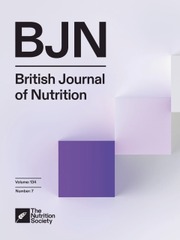No CrossRef data available.
Article contents
Effects of multi-species synbiotic supplementation on circulating miR-27a, miR-33a levels and lipid parameters in adult men with dyslipidaemia; a randomised, double-blind, placebo-controlled clinical trial
Published online by Cambridge University Press: 30 April 2024
Abstract
MicroRNAs (miRNAs) have emerged as important regulators of lipid metabolism. Recent studies have suggested synbiotics may modulate miRNA expression and lipid metabolism. This study aimed to investigate the effects of synbiotic supplementation on circulating miR-27a, miR-33a and lipid parameters in patients with dyslipidaemia. Fifty-six eligible participants were randomly allocated to receive either synbiotic or placebo sachets twice a day for 12 weeks. Each synbiotic sachet contained 3 × 1010 colony forming unit six species of probiotic microorganisms and 5 g of inulin and fructooligosaccharide as prebiotics. Serum miR-27a and miR-33a expression levels, serum lipids and apolipoproteins, the fecal concentration of short-chain fatty acids (SCFA) and Firmicutes and Bacteroidetes phyla were assessed before and after the study. Real-time PCR was used to determine the relative expression levels of miRNAs. The results showed synbiotic supplementation significantly downregulated the expression levels of miR-27a and miR-33a compared with the placebo group (P = 0·008 and P = 0·001, respectively). Furthermore, the intervention group exhibited significant improvements in serum HDL-cholesterol, small dense LDL (sdLDL-cholesterol), apoA-I and apoB-100 (P = 0·008, P = 0·006, P = 0·003, P = 0·001, respectively). The results showed a significant negative correlation between miR-33a expression levels with HDL-cholesterol, butyrate, propionate and a significant positive correlation with total cholesterol, LDL-cholesterol and sdLDL-cholesterol in the intervention group. Fecal bacteria and SCFA were significantly increased in the intervention group. This study provides evidence that synbiotic supplementation can modulate miR-27a and miR-33a expression and improve lipid metabolism in patients with dyslipidaemia.
- Type
- Research Article
- Information
- Copyright
- © The Author(s), 2024. Published by Cambridge University Press on behalf of The Nutrition Society



